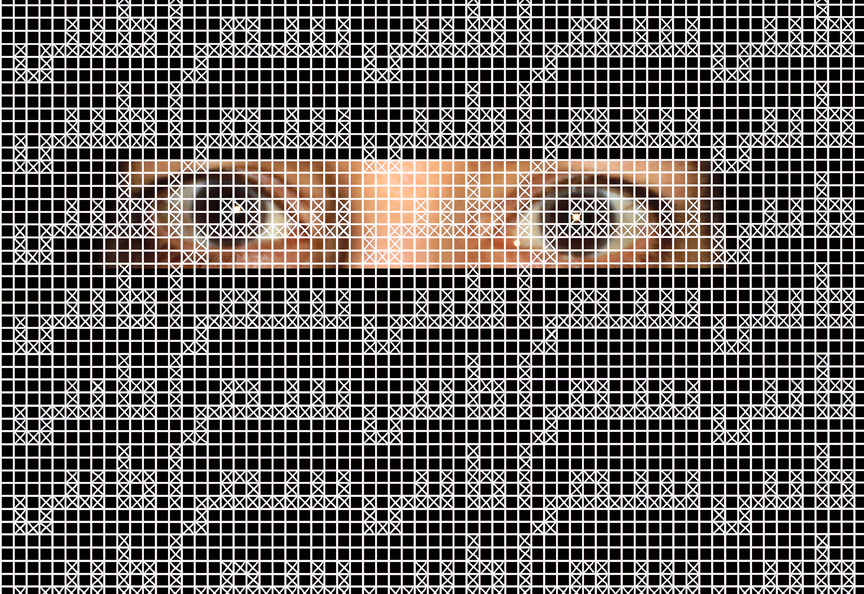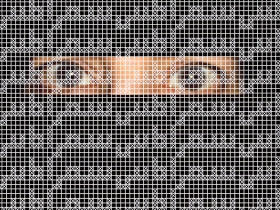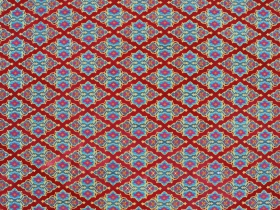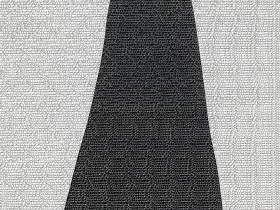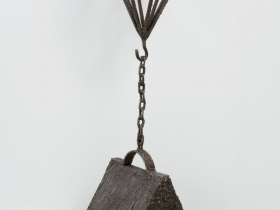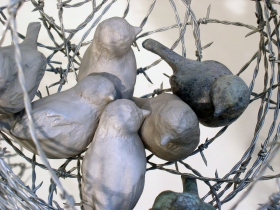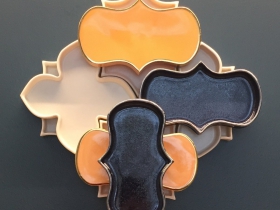Bridge Over Troubled Waters
MIAD show features women artists from many countries bridging cultures and colors.
As I entered “I Contain Multitudes” in the Frederick Layton Gallery on MIAD’s lower level, I was met with five video screens showing a woman on all fours, balancing on her back both a bench and a man on all fours. Nida Bangash’s, “The Bridge Called My Back” is a powerful metaphor for this show, which bridges many cultures, with works by 10 women artists born or raised in Iran, Saudi Arabia, Somalia, Nigeria, Lebanon and the United States. The exhibition’s title is from a Walt Whitman poem and the show does encompass so much: paintings, drawings, mixed media objects and installations with themes of multiculturalism, immigration and diversity in a largely patriarchal society.
Farida Hughes’ paintings from her series, “Blends” began when she solicited lists of the ethnicities of her friends and acquaintances. Colors symbolizing those people and their family members overlap in semi-transparent pools to form glowing abstract paintings of multiculturalism frozen in resin. The lists submitted by her subjects are printed next to the pieces and offer an intriguing glimpse into their making.
From across the gallery, I gravitate to a life-sized drawing of a brown wooden chair with a delicately valued shadow. Upon closer inspection, I was amazed to see that it was made up of Sufi words, superimposed on each other to create value and form. The piece, “Grandfather’s brown chair”, by the show’s curator, Nina Ghanbarzadeh, spurred questions in my mind: what did these words say and were they about her relationship to her grandfather? Like many pieces in this show, upon closer inspection the work contains multitudes of marks and meanings.
Near this piece, I noticed a bed-sized pedestal and tentatively walk around it to see a woman laying on her back, legs spread and knees bent, who is totally covered in a golden blanket with words describing women taken from religious texts. “Shameful” and “Stone her to death” are sown on a covering whose only hemmed and adorned opening is over her vagina. This powerful piece by Fawzia Khan was partly inspired by a scene in the novel by Laura Esquivel, Like Water for Chocolate.
In Ifrah Mansour’s installation piece, “Can I Touch It”, we watch a screen on the ground as a woman rolls in place to put on her head wrap while also gracefully holding an empty bucket in her feet. The actual fabric is displayed in the gallery and is worn by a mannequin seated on the gallery floor watching the video as a single eye projected on the fabric is watching the viewer.
In the sculptural work of Roya Farassat, the cultural stereotype of a woman’s handbag is transformed through welded steel, the weight and sharpness of these pieces and their menacing points and spikes powerfully portraying the idea of carrying psychological “baggage”.
Upon entering Hend Al-Mansour’s installation “Blue Roots”, I became very aware I was walking into a womb-like space, the walls are made of screen printed designs on glassine paper creating a room glowing from the outer gallery lights. A life-sized painting of a mother and child dressed in gold sit on a bed to greet me in this temporary sacred space.
The porcelain pieces of Kimberlee Joy Roth hang like huge heavy flowers on the gallery walls, each petal a shallow vessel ready to hold culture’s dew with a nod to Art Nouveau and Islamic design. And in Susan Armington’s mixed-media work, we are taken along on her journey through her hand, we see how each piece is made and traveled through. In her landscapes the marks are walked rather than drawn and we become more of a travel companion and less of a viewer.
This collective of femininity expressed through many forms of art powerfully conveys the complexity of emotions and challenges that women of different cultures have faced and continue to face daily. The work in this exhibition is a bridge that can connect to a multitude of emotions in any viewer that wishes to cross it.
“I Contain Multitudes” Gallery
“I Contain Multitudes,” through March 9 at MIAD’s Frederick Layton Gallery, 273 E. Erie St., Milwaukee, WI.
If you think stories like this are important, become a member of Urban Milwaukee and help support real independent journalism. Plus you get some cool added benefits, all detailed here.
Art
-
Winning Artists Works on Display
 May 30th, 2024 by Annie Raab
May 30th, 2024 by Annie Raab
-
5 Huge Rainbow Arcs Coming To Downtown
 Apr 29th, 2024 by Jeramey Jannene
Apr 29th, 2024 by Jeramey Jannene
-
Exhibit Tells Story of Vietnam War Resistors in the Military
 Mar 29th, 2024 by Bill Christofferson
Mar 29th, 2024 by Bill Christofferson



